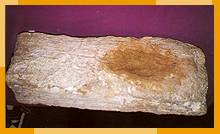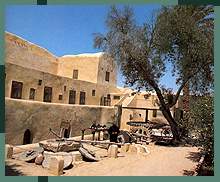|
Holy
Family
THE
HOLY FAMILY AT EL-ZARANIK AND FARMA
 Christ's footprint on a stone - Virgin
Mary Church - Kafr El Sheikh
Christ's footprint on a stone - Virgin
Mary Church - Kafr El Sheikh |
According
to the sources of the Coptic Church, the Holy Family proceeded
from Bethlehem to Gaza, and then to El-Zaraniq (also
known as Floussiat), some 37 kms west of El-Arish; then they
threaded their way along northern Sinai until they reached
Farma (ancient Pelusium) mid-way between El-Arish and present-day
Port Said. Their last stop was in Sinai; and with the next
leg of their journey they put the perils of the wilderness
behind them.
THE
HOLY FAMILY AT BASTA TOWN
Tel
Basta - or Basta which they now enter, is a short distance
from Zagazig, the main town in the Sharqiah Governorate, about
100 kms north-east of Cairo. Here, Jesus caused a waterspring
to well up from the ground, and His presence caused the idols
to crumble, as foretold by the prophets. The townsfolk, in
consequence, turned malevolent and aggressive, whereupuon
the Holy Family turned their backs on the town and headed
southwards.
In
due course, they reached Mostorod (called, in those days,
'Al Mahamma') about 10 kms away from Cairo. 'Al Mahamma' means
'the Bathing Place', a name given to the town because the
Virgin Mary bathed Christ and washed his clothes there. It
is worth noting that, eventually, on their way back to Palestine,
the Holy Family stopped once more at Mostorod. Jesus caused
a spring to gush from the earth which still flows to the present
day.
THE
HOLY FAMILY AT THE TOWN OF BELBEIS
From
Mostorod, the Holy Family made their way north-eastwards to
Belbeis (ancient Philippos), back in Sharqiah Governorate,
about 55 kms from Cairo. They rested there in the shade of
a tree which came to be called, 'The Virgin Mary's Tree'.
|

|
THE
HOLY FAMILY AT MENIET SAMANOUD
Having
left their mark on Belbeis, the Holy Family set off in a north-westerly
direction and, reaching the small township of Meniet Samanoud
(known also Meniet Genah), they crossed the Nile to the city
of Samanoud (or Jemnoty) in the Delta, where the local population
received them with a kindness and hospitality that earned
them deserved blessing. To this day, in Samanoud, there is
a large granite trough which, according to local belief, was
used by the Virgin for kneading dough, and a water-well which
the Christ Child Himself hallowed.
Again
towards the north west the Holy Family now travelled until
they reached the city of sakha, in the lake district of burullus
in the present day governorate of Kafr El-Sheikh.
THE
HOLY FAMILY AT SAKHA TOWN
The
coptic name of the town, 'Pekha-Issous', (vernacularized to
Lysous) means, 'the foot of Jesus'; for the Holy Child's foot
print was marked, here, in bas-relief on a rock. The rock
was preserved, but hidden for centuries for fear of robbery,
and only unearthed again 13 years ago.
The
natural course of the Holy Family's journey from Samannoud
to Sakha would have taken them through many of the towns and
cities now lying in both the Governorates of Gharbia and Kafr
El-Sheikh and, according to traditions, through the Belqas
wastelands as well.
THE
HOLY FAMILY AT WADI EL NATROUN
 Grapes Squeezer at El- Sorian Monastery
Grapes Squeezer at El- Sorian Monastery |
Their
trail from Sakha, is recorded in the documentation of Pope
Theophilus's vision, and attested to by Coptic practice in
the Christian era. After crossing the Rosetta branch of the
Nile to the western Delta, they headed south in Wadi el-Natroun
(then called Al Asqeet) in the Western Desert of Egypt. In
the earliest decades of Christianity, the desert expanses
of Wadi el-Natroun became the site of many monasteries in
spiritual commemoration of the Holy Family's passage through
the Valley.
|
|